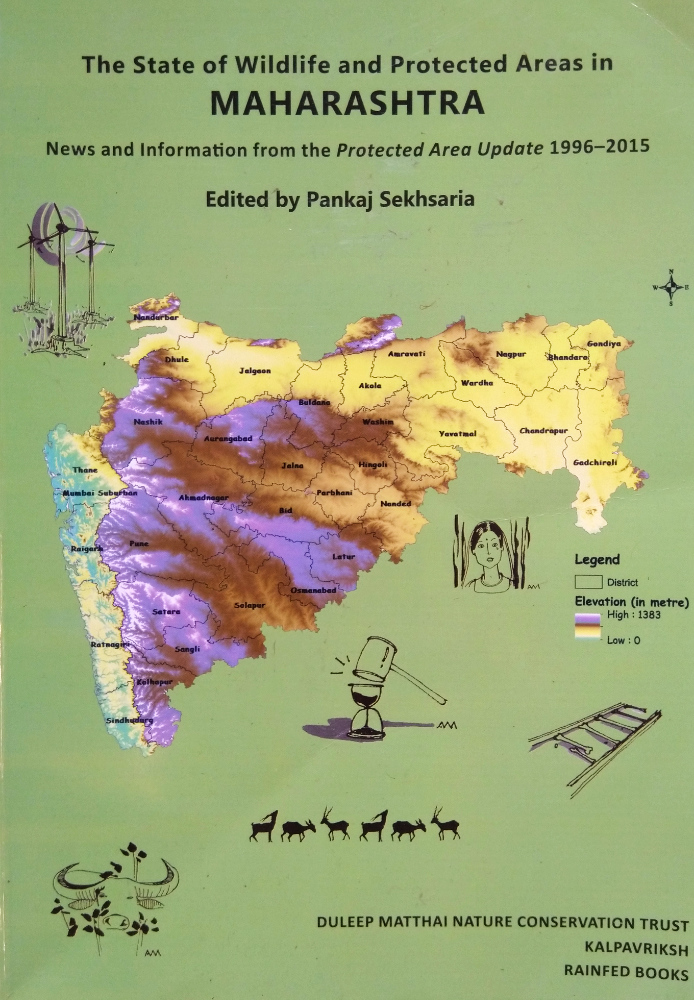The State of Wildlife and Protected Areas in Maharashtra
Edited by Pankaj Sekhsaria
I have been trying to review the book “The State of Wildlife and Protected Areas in Maharashtra” edited by Pankaj Sekhsaria for the last few months but the Covid 19 had played spoilsport. Nevertheless, finally when I was able to turn the pages of the book, I found myself transported in time as this book contains news and information published in the PA updates from 1996 to 2015 in the first section.
Around 300 news items about various wildlife sanctuaries, conservation reserves, Tiger reserves and other protected areas of Maharashtra bunched under each protected area provides us a rare glimpse to a chronological evolution of the place. In most of the cases one can see how a wildlife sanctuary or tiger reserve has increasingly faced pulls and pressures from various challenges and lobbies and the resulting impact. In certain cases while reading these news items one can also get an idea or pinpoint the person who set in motion a chain of conservation challenges or who approved an ill-thought out idea resulting in environmental degradation.
Politicians often ignore wellbeing of forests and environment. In 2003, even though MoEF had refused to give clearance the then Chief Minister of Maharashtra Shri Sushil Kumar Shinde was keen to go ahead with four hydro-electric power projects in Chikhaldara in Amravati, Humbarli in Satara, Kardi-Bhogiv in Kolhapur and Malsej Ghat in Pune district. One also gets to learn that political lobbying had obstructed the final declaration of Rajmachi and Tamhini Sudhagarh wildlife sanctuaries in the western ghats in Pune and Raigad districts. Though the proposal was given in principle approval by the State Wildlife Advisory Board in 1998-99, stiff pressures to protect luxurious farmhouses and weekend resorts of political and corporate headhonchos resulted in the obstruction.
This book also records the negative impact of politicians in Tadoba-Andhari Tiger Reserve. In 2007 December Maharashtra Finance Minister Jayant Patil had violated rules and entered into the forest at the middle of the night. When a minister enters, he comes with a huge entourage and all those people including their security keep on moving and creating disturbance in the forest. At that time, I was told that this is one of the triggers for the forest department deciding to close the forest rest house to public. In another instance Maharashtra Govt. had clarified that in 2007 a tiger was killed in the name of getting rid of a maneater whereas a tigress seemed to have killed people. MLA of Chimur, Vijay Wadettiwar had wrote a letter serving an ultimatum to kill the maneater within 15 days. The forest department had got pressurized to kill a tiger, any tiger for that matter it seems. So when they found a tiger eating its kill they fired 39 bullets out of which 12 hit and felled the tiger.
The manpower problem faced by the forest department also gets highlighted showing that in one case a range officer post in Tadoba remained vacant for 9 months and in Moharli range RFO position remained vacant for 21 months. One news snippet talks about opposition to opening up of Kolara gate for tourists. There has been an allegation of forest officials and their relatives purchasing land near the Kolara gate and hope to make financial gains when a tourist entry point is created in that area. In India we have often seen such conflicts of interest which somehow get pushed under the carpet. These kinds of ethical challenges also make local people lose hope with the officials.
Various news items talk about the efforts to push through Adani coal mining project. In 2009 MoEF said that it was not aware that the coal mining projects of Adani Power Limited in Lohara and that of Maharashtra Coal Company in Agarzari were so close to the tiger corridor. A 2011 Greenpeace report talks about 2558 hectares of forestland diverted for coal mining in Chandrapur district since 2000. This is despite MoEF refusing clearance to Adani coal mining project in 2009. Coal mining devastates the forest corridors used by tigers to pass from Tadoba-Andhari Tiger reserve to Chaprala, Indravati, Bor and other forests.
If these challenges are not enough, one is reminded about tiger deaths in railway tracks and by professional poachers using traps, challenges of creating underpass in the NH-6, relocation of villages from within the reserve, impact of canals, lack of salaries to forest workers etc. These kind of information gives us a 360 degree view of the challenges faced by a tiger reserve and one can understand that all our protected areas would be facing similar problems. So this book will be of lot of help to researchers as well as policy makers who want to quickly get a short historical context of each protected area in Maharashtra.
Apart from the news and information about various wildlife sanctuaries, conservation reserves, Tiger reserves and other protected areas of Maharashtra contained in the first section of the book, the second section contains five interesting articles providing analysis. One of those is an analysis of the media reporting on protected areas in Maharashtra.
The role of media in disseminating information and shaping public opinion is very important. So the article analysing media reporting on PAs in Maharashtra is interesting. It talks about the implicit bias in the reporter about the wildlife issues. Also some protected areas get more coverage than others due to their proximity to a major city. It also talks about the role of land in conflicts “With India’s PA network being a dynamic, evolving scene of negotiations, protests and legal interventions, land emerged as the second most important theme in our analysis”. A very important question that this article asks is “why is there such a strong emphasis on socio-political dimension of conservation while science-based reporting is largely missing?”
In this TRP/eyeballs driven media, responding to sentiments rather than science is an easy choice. Furthermore, the understanding of scientific concepts and ecology to understand the issues and then explain it in media is difficult for untrained poorly paid journalists. The business of media is designed for earning money and influence and hence science-based reporting is not often on their radar. The second article regarding Coverage of Conservation and Wildlife in the Marathi Print Media points out that there are no journalists in this vernacular media dedicated to wildlife and environment. So there is a need for collaboration with experts, NGOs and other research agencies so that readers of Marathi media can be educated about wildlife and environment. Existing publications can also be translated into Marathi. A lot of human-animal conflict arises because people who have no idea about wildlife get tensed when they see an animal. Such collaborations can raise understanding about the underlying issues and help save lives. The article also talks about writing letters to editor to raise issues and force the vernacular media to take it up.
The article “Dividing Lines: Tribal Rights and Tiger Reserves” talks about the various challenges people face after relocation to a new site. We humans are creature of habit. After relocation people find a different environment, new neighbours, loss of identity and at times loss of livelihoods. Hence it is imperative that relocation of villages needs to be done with a lot of thought. There was a time when the human footprint of the forest dwellers was less. However, with exploding human population the impact of people on the wilderness and wildlife also can’t be rejected. I had personally seen villagers of Kolsa in Tadoba-Andhari Tiger Reserve setting the forest on fire as they were angry that a tigress with small cubs killed a cow. Hundreds of hectares were burnt and that didn’t get covered in media. It would be very important that impartial NGOs and agencies act in understanding the overall issues of each protected area and help resolve the issues if any between the forest department and people.
This book also contains an interesting article on the rocky plateaus in the parts of western ghats in Maharashtra where upto 188 endemic plant species had been recorded. These plateaus are important landscapes to be protected not just from a biodiversity hot spot perspective but also for their importance to the local villagers as “they act as water towers, absorbing and then slowly releasing rainwater from the sides in the form of perennial springs”. It also details the various conservation challenges posed by mining, wind farms and tourism. The second section also has an article on various community conserved areas in Maharashtra.
Published by Duleep Mathai Nature Conservation Trust, Kalpavriksh and Rainfed Books, “The State of Wildlife and Protected Areas in Maharashtra” is 235 pages thick and is priced at Rs. 400/- . This is not a typical natural history or wildlife conservation book. However, serious readers, researchers, conservationists as well as planners will find it useful. Even though this is not an exhaustive account of all the issues reported in media regarding PAs of Maharashtra, this book will help authorities to get a quick understanding of the underlying challenges or issues in some of the protected areas in Maharashtra. It will help as a good reference book and an invaluable tool for some. The book is available in Amazon to buy.
- GoPro Hero 12 Black - 6 September,2023
- Leopards: The Last Stand - 2 July,2023
- Drifting in the Waters of Sundarbans - 26 March,2023














Leave a Reply